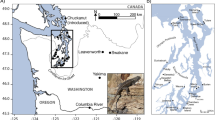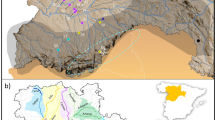Abstract
The colonization of a new habitat is a fundamental process in metapopulation biology1, but it is difficult to study. The emigration of colonists from established populations might be induced by resource competition owing to high local population density2,3. Migration distances are also important because they determine the frequency and scale of recolonization and hence the spatial scale of the metapopulation4. Traditionally, these factors have been investigated with demographic approaches that are labour-intensive and are only possible in amenable species. In many cases, genetic differentiation is minimal, preventing traditional genetic approaches from identifying the source of colonists unambiguously. Here we present a bayesian approach that integrates genetic, demographic and geographic distance data. We apply the method to study the British metapopulation of grey seals, which has been growing at 6% per year over the last few decades5. Our method reveals differential recruitment to three newly founded colonies and implicates density-dependent dispersal in metapopulation dynamics by using genetic data.
This is a preview of subscription content, access via your institution
Access options
Subscribe to this journal
Receive 51 print issues and online access
$199.00 per year
only $3.90 per issue
Buy this article
- Purchase on Springer Link
- Instant access to full article PDF
Prices may be subject to local taxes which are calculated during checkout


Similar content being viewed by others
References
Hanksi, I. Metapopulation dynamics. Nature 396, 41–49 (1998).
Johnson, C. Insect Migration and Dispersal by Flight (Methuen, London, 1969).
Baker, R. The Evolutionary Ecology of Animal Migration (Hodder & Stoughton, London, 1978).
Hanski, I. Metapopulation Ecology (Oxford Univ. Press, Oxford, 1999).
Hiby, A. R., Duck, C. D., Thompson, D., Hall, A. J. & Harwood, J. Seal stocks in Great Britain. NERC News, January (1996).
Pomeroy, P., Twiss, S. & Redman, P. Philopatry, site fidelity and local kin associations within grey seal breeding colonies. Ethology 106, 899–919 (2000).
Whitlock, M. C. Nonequilibrium population structure in forked fungus beetles: extinction, colonization, and the genetic variance among populations. Am. Nat. 139, 952–970 (1992).
Ingvarsson, P. K. Kin-structured colonization in Phalacrus substriatus. Heredity 80, 456–463 (1998).
Giles, B. E. & Goudet, J. Genetic differentiation in Silene dioica metapopulations: Estimation of spatiotemporal effects in a successsional plant species. Am. Nat. 149, 507–526 (1997).
Milner, G., Teel, D., Utter, F. & Winans, G. A genetic method of stock identification in mixed populations of pacific salmon, Oncorhynchus spp. Mar. Fish. Rev. 47, 1–8 (1985).
Rannala, B. & Mountain, J. L. Detecting immigration by using multilocus genotypes. Proc. Natl Acad. Sci. USA 94, 9197–9201 (1997).
Pritchard J. K., Stephens, M. & Donnelly, P. Inference of population structure using multilocus genotype data. Genetics 155, 945–959 (2000).
Spiegelhalter, D. J., Best, N. G., Carlin, B. P & van der Linde, A. Bayesian measures of model complexity and fit. J. R. Statist. Soc. B 64 (in the press).
Hastings, W. K. Monte Carlo sampling methods using Markov chains and their applications. Biometrika 57, 97–109 (1970).
Metropolis, N., Rosenbluth, A. W., Rosenbluth, M. N., Teller, A. H. & Teller, E. Equation of state calculations by fast computing machines. J. Chem. Phys. 21, 1087–1092 (1953).
Acknowledgements
The manuscript was read critically by I. Hanksi, R. Lande and P.E. Smouse.
Author information
Authors and Affiliations
Corresponding author
Ethics declarations
Competing interests
The authors declare that they have no competing financial interests
Supplementary information
Rights and permissions
About this article
Cite this article
Gaggiotti, O., Jones, F., Lee, W. et al. Patterns of colonization in a metapopulation of grey seals. Nature 416, 424–427 (2002). https://doi.org/10.1038/416424a
Received:
Accepted:
Issue Date:
DOI: https://doi.org/10.1038/416424a
This article is cited by
-
Genetic diversity from pre-bottleneck to recovery in two sympatric pinniped species in the Northwest Atlantic
Conservation Genetics (2018)
-
Integration of genetic and demographic data to assess population risk in a continuously distributed species
Conservation Genetics (2017)
-
Landscape connectivity analysis for conservation: insights from combining new methods with ecological and genetic data
Landscape Ecology (2012)
-
Genetics in geographically structured populations: defining, estimating and interpreting FST
Nature Reviews Genetics (2009)
-
Rapid increase of the grey seal (Halichoerus grypus) breeding stock at Helgoland
Helgoland Marine Research (2009)
Comments
By submitting a comment you agree to abide by our Terms and Community Guidelines. If you find something abusive or that does not comply with our terms or guidelines please flag it as inappropriate.



